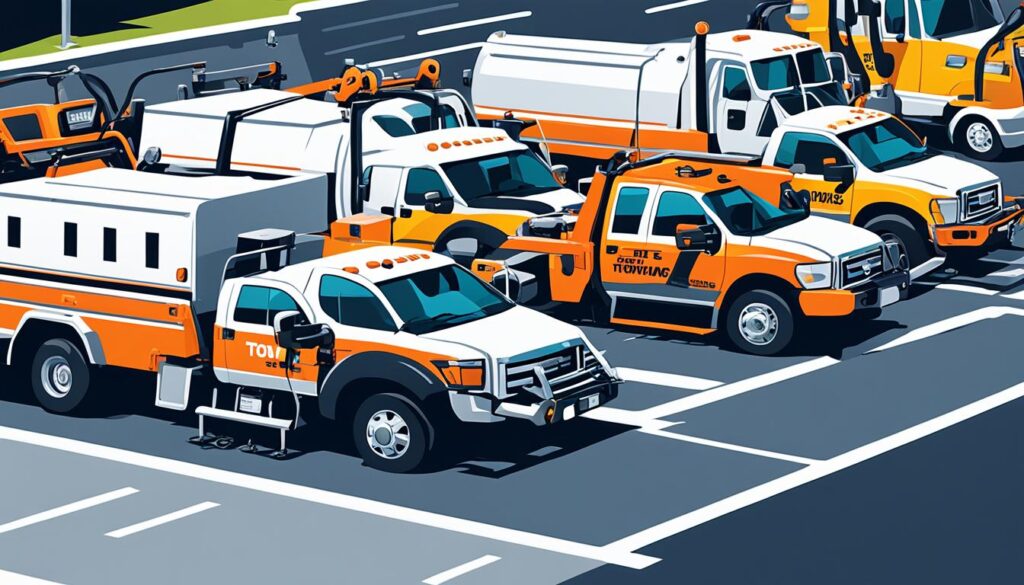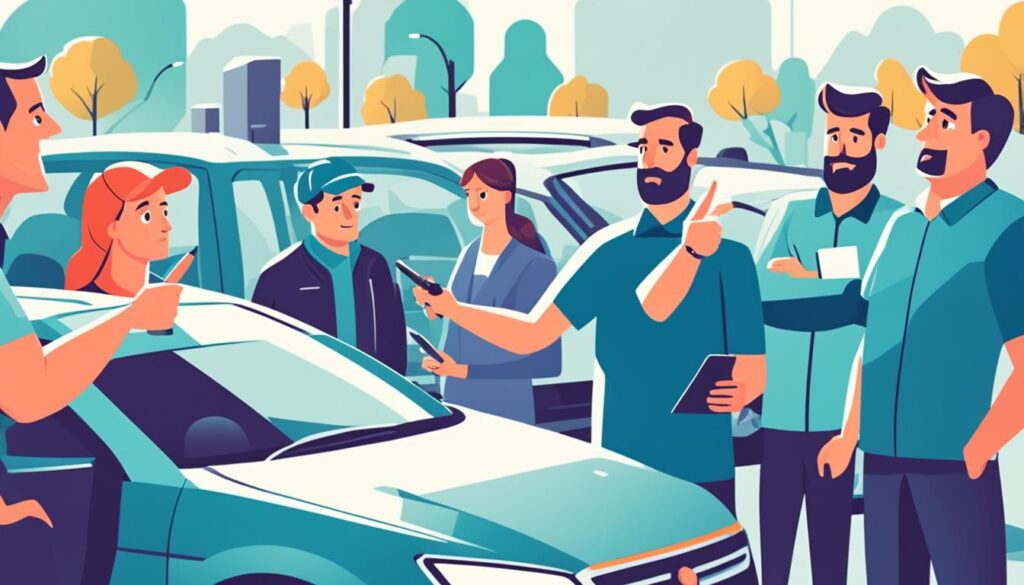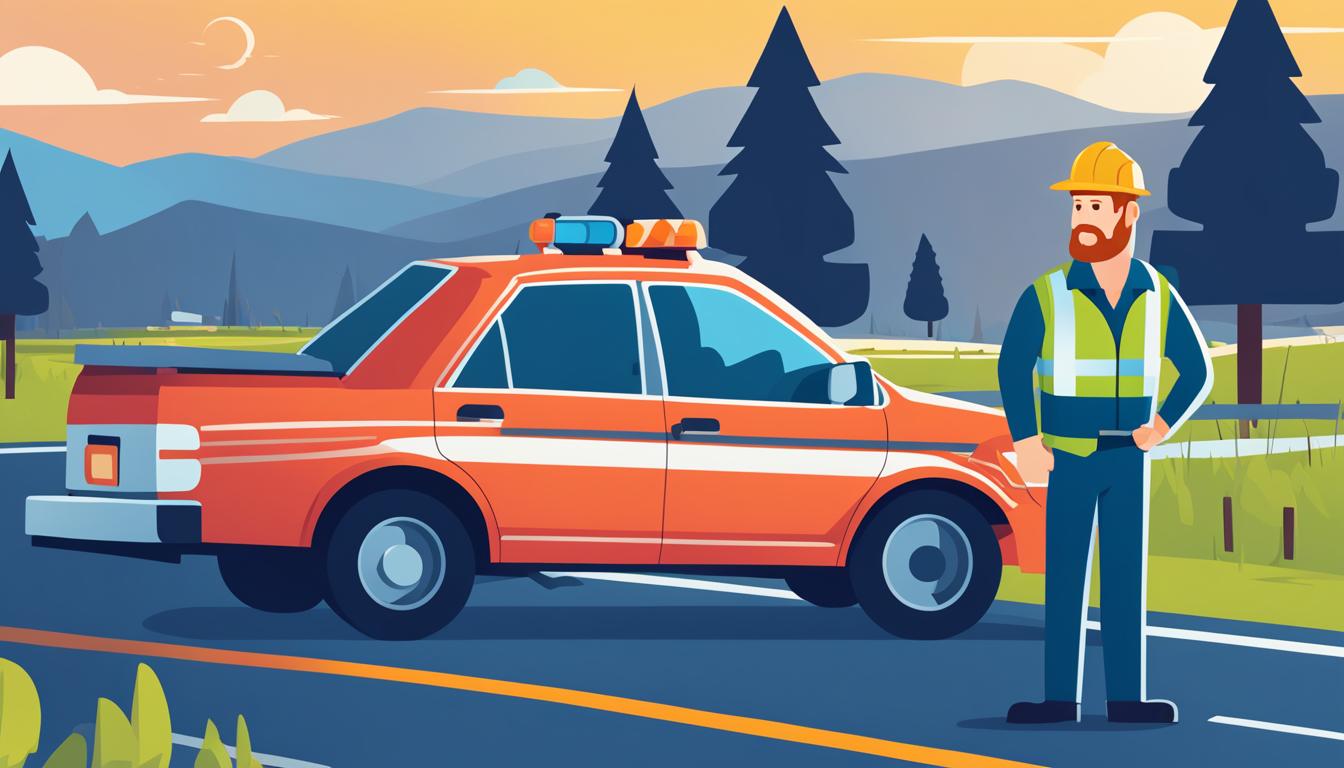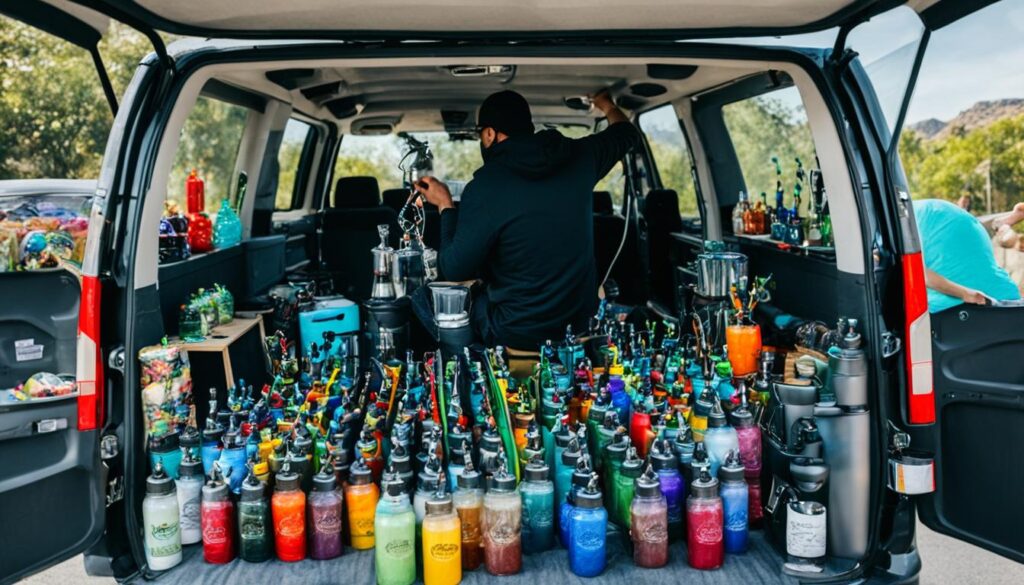Did you know that more than 97% of the US population owns a smartphone? This widespread adoption has led to a significant increase in demand for roadside assistance services. In fact, each day in the US sees hundreds of thousands of calls for roadside assistance, highlighting the immense potential in this market.
Starting a tow truck business or offering mobile automotive services can be a lucrative venture, but it requires careful planning and execution. To embark on this journey, you’ll need to gather information, decide on the time and effort you want to devote, acquire the right tools and equipment, choose a legal business structure, obtain the necessary business insurance, set up business bank accounts, and invest in marketing.
The financial investment required to start a roadside service business depends on the range of services you plan to offer and the quality of equipment you desire. Licensing and business registrations can cost as low as $200-$350, while equipment expenses (excluding service vehicles) typically range from $1,500 to $5,000. Additionally, business insurance premiums can vary from $100 to $400 or more, depending on your coverage needs.
To succeed in this competitive industry, it’s essential to prioritize customer service training for your team, streamline dispatch management, and ensure proper fleet maintenance. By focusing on these key aspects and leveraging the growing demand for emergency vehicle operations, vehicle recovery, and impound services, you can position your business for long-term success.
Key Takeaways:
- The widespread use of smartphones has led to a significant increase in demand for roadside assistance services.
- Starting a roadside service business requires careful planning, including acquiring the right equipment, obtaining necessary licenses and insurance, and investing in marketing.
- Financial investments for starting a roadside service business can vary depending on the range of services offered and the quality of equipment desired.
- Prioritizing customer service training, streamlining dispatch management, and ensuring proper fleet maintenance are crucial for success in this competitive industry.
- Leveraging the growing demand for emergency vehicle operations, vehicle recovery, and impound services can help position your business for long-term success.
Understanding the Roadside Assistance Industry
The roadside assistance industry has experienced significant growth in recent years, driven by the increasing number of vehicles on the road and the growing demand for reliable emergency services. When your vehicle breaks down, you need a trusted provider to help you get back on the road quickly and safely. That’s where roadside assistance services come in, offering a wide range of solutions to meet your needs.
The Growing Demand for Roadside Services
As more people rely on their vehicles for daily transportation, the demand for roadside assistance services continues to rise. Whether you’re dealing with a flat tire, a dead battery, or an empty fuel tank, having access to prompt and professional assistance can make all the difference. With the increasing popularity of on-demand app solutions, customers now expect even greater convenience when it comes to emergency roadside services.
Types of Roadside Assistance Services
Roadside assistance providers offer a variety of services to help you get back on the road safely and efficiently. Some of the most common types of roadside assistance services include:
- Towing services: If your vehicle is unable to be repaired on the spot, a tow truck can transport it to a nearby repair shop or your desired location.
- Flat tire repair: A technician can change your flat tire with your spare or provide a temporary repair to help you reach a service station.
- Dead battery jump-start: If your battery has died, a service provider can jump-start your vehicle to get you back on the road.
- Fuel delivery: Running out of gas can be a frustrating experience, but roadside assistance can bring you enough fuel to reach the nearest gas station.
- Lockout services: If you’ve locked your keys inside your vehicle, a technician can help you gain access to your car without causing damage.
- Winching: If your vehicle is stuck in a ditch or on a steep incline, winching services can help pull it back onto the road.
By understanding the growing demand for roadside services and the various types of assistance available, you can better appreciate the importance of this industry and the value it provides to drivers in need. When starting your own roadside assistance business, it’s crucial to recognize the diverse needs of your potential customers and develop a comprehensive range of services to meet those needs effectively.
Developing Your Business Plan
Creating a comprehensive business plan is crucial for the success of your roadside assistance business. A well-thought-out plan will guide you through the initial stages of your venture and help you navigate the challenges ahead. Over the past 20+ years, more than 500 entrepreneurs have been assisted in creating business plans for their roadside assistance companies, highlighting the importance of this essential document.
Defining Your Target Market
To effectively serve your customers, you must first identify your target market. Conduct thorough market research to understand the demographic and psychographic profiles of your potential clients, such as:
- Elderly drivers
- Individual vehicle owners
- RV drivers
- Uninformed drivers
By understanding your target market’s needs and preferences, you can tailor your services and marketing strategies to attract and retain customers.
Identifying Your Unique Selling Proposition
In a competitive industry like roadside assistance, it’s essential to differentiate your business from others. Identify your unique selling proposition (USP) – the factor that sets you apart from your competitors. This could be your exceptional customer service, state-of-the-art equipment, or 24/7 availability. Emphasize your USP in your marketing efforts to attract customers and establish your brand identity.
Estimating Startup Costs and Revenue Potential
A crucial aspect of your business plan is estimating your startup costs and revenue potential. Personal savings and bank loans are the most common sources of funding for roadside assistance businesses. Be realistic about your goals and expectations when projecting your revenue potential. Consider factors such as:
- Market size and growth forecasts
- Competitive landscape
- Pricing strategy
- Operating expenses
By carefully analyzing these factors, you can create a financial plan that ensures the long-term viability of your roadside assistance business.
Acquiring the Necessary Equipment and Tools
To provide top-notch roadside assistance services, you’ll need to invest in the right equipment and tools. The specific items you’ll require depend on the range of services you plan to offer. Some essential pieces of equipment for a well-rounded roadside service business include tow trucks, flatbed carriers, winches, dollies, air compressors, battery chargers, and tire repair kits.

Safety should always be a top priority, so make sure to stock up on safety equipment such as reflective triangles, flares, and high-visibility clothing for your technicians. In addition to the physical tools, consider investing in technology that can help streamline your operations, such as GPS tracking for your vehicles and dispatch software to efficiently manage job assignments.
When purchasing equipment, consider factors such as:
- Quality and durability of the products
- Ease of use and maintenance
- Compatibility with your existing equipment and vehicles
- Cost-effectiveness and return on investment
As your business grows, you may need to expand your equipment inventory to accommodate a wider range of services or a larger customer base. Regularly assess your equipment needs and budget for necessary upgrades or replacements to ensure your technicians have the tools they need to provide excellent service to your customers.
Obtaining Licenses, Permits, and Insurance
Before launching your roadside service business, it’s crucial to ensure that you have all the necessary licenses, permits, and insurance coverage. Failing to comply with legal requirements can result in severe penalties and jeopardize the success of your business. In this section, we’ll guide you through the process of registering your business, obtaining the required licenses and permits, and securing adequate insurance coverage.
Registering Your Business
The first step in starting your roadside service business is to register your company with the appropriate government agencies. Business registration is essential for paying taxes, raising financing, and opening a bank account. Visit the websites of your State, Local, and County Governments or contact a qualified person to learn more about the specific requirements and procedures for registering your business in your area.
Obtaining the Required Licenses and Permits
To operate legally, your roadside service business will need to obtain various licenses and permits. These may include a general business license, a towing license, and any other industry-specific permits required by your local government. Research the licensing requirements in your area and ensure that you have all the necessary documentation before launching your business. Failing to comply with legal standards can result in fines, penalties, and even the closure of your business.
Securing Adequate Insurance Coverage
Insurance is a critical component of any roadside service business. It protects you, your employees, and your customers from potential accidents, injuries, and financial losses. When selecting insurance coverage for your business, consider the following types of policies:
- General liability insurance: Protects your business from third-party claims of bodily injury, property damage, and personal injury.
- Professional liability insurance: Covers claims arising from errors or omissions in the services you provide.
- Vehicle insurance: Protects your tow trucks and other service vehicles from accidents, theft, and damage.
- Workers’ compensation insurance: Provides coverage for employees who are injured or become ill on the job.
- Income protection insurance: Helps replace lost income if you are unable to work due to an injury or illness.
- Business owner’s policy: Combines general liability, property, and business interruption insurance into a single policy.
Work with a reputable insurance agent or broker to determine the appropriate coverage levels for your roadside service business. Regularly review and update your insurance policies to ensure that you remain adequately protected as your business grows and evolves.
Establishing Partnerships and Contracts
As you embark on your journey to start a roadside service business, establishing partnerships and securing contracts with local businesses, organizations, insurance companies, and motor clubs is crucial for generating a steady stream of business. By networking and forming these relationships, you can position yourself as a reliable independent contractor and tap into a wealth of opportunities.
Networking with Local Businesses and Organizations
Connecting with local businesses and organizations is an excellent way to secure contracts for your roadside assistance services. By partnering with top insurance companies and making money, you can expand your reach and attract more customers. Consider the following strategies:
- Attend local business events and trade shows to meet potential partners
- Join local chambers of commerce and business associations
- Offer discounted rates or package deals to incentivize partnerships
- Provide exceptional service to build a positive reputation and encourage referrals
Securing Contracts with Insurance Companies and Motor Clubs
Insurance companies and motor clubs are always in need of reliable roadside assistance providers to serve their customers. By securing contracts with these organizations, you can ensure a consistent flow of business for your company. To increase your chances of landing these contracts, consider the following:
- Research the requirements and application processes for each organization
- Demonstrate your expertise, experience, and commitment to quality service
- Offer competitive pricing and flexible service options
- Maintain proper licensing, insurance, and certifications
- Develop a strong online presence and invest in SEO to improve your visibility
By establishing a strong network of partnerships and contracts, you can create a solid foundation for your roadside service business. Remember to consistently deliver exceptional service and maintain open lines of communication with your partners to foster long-lasting, mutually beneficial relationships.
Building Your Team
As your roadside service business grows, hiring skilled technicians, drivers, dispatchers, and mechanics becomes crucial to meet the increasing demand for your services. When recruiting new employees, it’s essential to follow anti-discrimination laws and set up a legally compliant payroll system to ensure fair treatment and compensation for all team members.

To maintain a high level of service quality and customer satisfaction, providing comprehensive training to your employees is vital. Your training program should cover various aspects of the job, including:
- Safety protocols and emergency procedures
- Vehicle recovery techniques and equipment operation
- Customer service and communication skills
- Dispatching and route optimization
- Basic automotive repair and maintenance
Hiring Skilled Technicians and Drivers
When hiring technicians and drivers, look for candidates with prior experience in the roadside assistance industry or related fields, such as automotive repair or towing services. Conduct thorough background checks and verify their driving records to ensure they meet your standards for safety and professionalism.
Providing Comprehensive Training
Invest in employee education and development by offering ongoing training opportunities, such as workshops, seminars, and certifications. Encourage your team members to expand their skills and knowledge, which will not only improve their performance but also boost employee morale and retention rates.
Once you have assembled a skilled and well-trained team, you can confidently launch your roadside service business and start generating profits while providing exceptional assistance to stranded motorists in your area.
Implementing Effective Marketing Strategies
To attract customers and grow your roadside service business, it’s crucial to implement effective marketing strategies that showcase your unique value proposition and build trust with potential clients. By developing a strong online presence, leveraging social media platforms, and engaging in local advertising, you can reach a wider audience and establish your business as a reliable provider of roadside assistance services.
Developing a Strong Online Presence
In today’s digital age, having a professional website is essential for any business. Your website should be user-friendly, informative, and optimized for search engines to improve your online visibility. Include details about your services, pricing, service area, and contact information. Additionally, claim your Google My Business listing to appear in local search results and make it easy for potential customers to find and contact you.
Leveraging Social Media and Local Advertising
Social media platforms like Facebook and Instagram provide excellent opportunities to engage with your target audience and showcase your expertise. Share helpful tips, industry news, and customer testimonials to build trust and credibility. Encourage satisfied customers to leave reviews on your social media pages and Google My Business listing to boost your online reputation.
To further increase your visibility, consider investing in local advertising. This can include:
- Partnering with local businesses to cross-promote services
- Sponsoring community events or local sports teams
- Distributing flyers and business cards in high-traffic areas
- Advertising in local newspapers, magazines, or radio stations
When developing your marketing strategies, it’s important to understand your target market and position yourself accordingly. Research your competitors’ pricing and services to ensure you offer competitive rates while still maintaining profitability. Consider offering introductory discounts or loyalty programs to attract new customers and encourage repeat business.
By consistently implementing these marketing strategies and delivering exceptional service, you can establish your roadside service business as a trusted provider in your community and drive long-term growth and success.
Managing Dispatch and Customer Service
To ensure the smooth operation of your roadside service business, implementing an efficient dispatch system is crucial. Dispatch systems like Towbook, Swoop, Dispatch Anywhere, and Call Rail can help you manage job assignments and communicate effectively with your drivers. These tools streamline the process of assigning tasks, tracking progress, and optimizing routes, ultimately improving your team’s productivity and response times.
In addition to a robust dispatch system, providing excellent customer service is essential for building a positive reputation and generating repeat business. Consider developing a mobile app that allows customers to request on-demand services, track the status of their requests, and provide feedback. A user-friendly app can enhance the customer experience and set your business apart from competitors.
To further improve customer service, implement the following strategies:
- Train your staff to be friendly, empathetic, and solution-oriented when interacting with customers
- Establish clear communication channels, such as a dedicated customer service phone line or live chat support
- Respond promptly to customer inquiries, complaints, and feedback
- Offer transparent pricing and provide accurate estimates for services
- Follow up with customers after service completion to ensure satisfaction and address any concerns
By prioritizing customer service and leveraging the right dispatch systems and mobile app solutions, you can create a seamless experience for your customers and establish a loyal customer base. Continuously monitor and optimize your processes to ensure that you are meeting the evolving needs of your target market and staying ahead of the competition.
Ensuring Compliance and Safety Standards
When starting a roadside service business, it is crucial to prioritize compliance with industry regulations and implement robust safety protocols. By adhering to the standards set by organizations like OSHA and DOT, you can avoid costly penalties and ensure the well-being of your employees and customers.
Adhering to Industry Regulations
Familiarize yourself with the specific regulations that apply to your roadside service business. These may include:
- OSHA standards for workplace safety
- DOT regulations for vehicle maintenance and operation
- State and local laws governing towing and roadside assistance services
Regularly review and update your policies and procedures to ensure ongoing compliance with industry regulations. Consider appointing a dedicated safety officer to oversee this process and keep your team informed of any changes.
Implementing Safety Protocols for Employees and Customers
Develop and implement comprehensive safety protocols to protect your employees and customers. These protocols should cover:
- Employee training: Provide thorough safety training to all employees, including proper vehicle operation, equipment handling, and emergency response procedures.
- Vehicle maintenance: Establish a regular vehicle maintenance schedule to ensure your fleet is always in safe, working condition. This includes inspections, repairs, and preventive maintenance.
- Customer safety: Implement measures to ensure customer safety during roadside assistance, such as properly securing vehicles during towing and providing clear instructions for customers to follow.
By prioritizing compliance and safety standards, you can build a strong foundation for your roadside service business, foster trust with your customers, and create a safe working environment for your employees.
How to Start a Roadside Service Business: Tips for Success
To excel in your new roadside service business, prioritize customer satisfaction above all else. Provide prompt, reliable, and friendly service to every customer in need. Encourage feedback after each service call and quickly address any concerns to build a loyal clientele. Positive reviews and word-of-mouth referrals are powerful for growing your business.
Investing in your employees is key to success. Foster a supportive work environment and provide comprehensive training to improve skills and retention. Well-trained, experienced technicians and drivers deliver higher quality service. As your team expands, implement effective financial management practices like budgeting, forecasting, and monitoring cash flow. This ensures you have the resources for payroll, equipment maintenance, and other critical expenses.
Stay alert to growth opportunities in your local market. As you serve more customers, analyze trends in service requests and feedback to identify potential new offerings. Adding services like roadside EV charging, motorcycle towing, or commercial fleet contracts can open up profitable niches. Networking with other roadside service business owners, joining industry associations, and attending conferences keeps you informed of evolving best practices, regulations, and technologies to remain competitive.
FAQ
How much does it cost to start a roadside assistance business?
FAQ
How much does it cost to start a roadside assistance business?
The amount of money needed to start a roadside assistance business depends on the services you intend to offer and how well you want to be equipped. Licensing and business registrations could run you as low as 0-0, equipment between
FAQ
How much does it cost to start a roadside assistance business?
The amount of money needed to start a roadside assistance business depends on the services you intend to offer and how well you want to be equipped. Licensing and business registrations could run you as low as $200-$350, equipment between $1,500-$5,000 not including service vehicles, and business insurance can cost between $100 to $400+.
What types of services do roadside assistance businesses provide?
Types of roadside assistance services include towing, flat tire repair, dead battery jump-start, fuel delivery, lockout services, and winching. As the popularity of on-demand app solutions increases, customers are looking for upgraded services that provide greater convenience.
What equipment do I need to start a roadside assistance business?
The number of tools you need is solely based on the services you want to provide. Basic equipment may include tow trucks, flatbed carriers, winches, dollies, air compressors, battery chargers, tire repair kits, and safety equipment. Investing in GPS tracking and dispatch software can help streamline operations and improve efficiency.
What licenses and permits are required to start a roadside assistance business?
Registering your business is necessary for paying taxes, raising financing, and opening a bank account. Visit the websites of your State, Local, and County Governments or contact a qualified person to learn more about license requirements and how to get them. Failure to comply with legal standards might result in severe penalties, so it’s essential to obtain the required licenses and permits.
What types of insurance do I need for my roadside assistance business?
Ensure you have the right insurance plans to protect yourself from accidents, including general liability, professional liability, vehicle insurance, medical coverage, trip interference coverage, workers’ compensation, income protection, and a business owner’s policy.
How can I secure contracts for my roadside assistance business?
There are many contracts available for roadside assistance services as an independent contractor. Networking with local businesses and organizations can help secure these contracts. Securing contracts with insurance companies and motor clubs is crucial for generating steady business. A strong online presence and SEO can help rank your business on Google and attract more customers.
What dispatch systems are recommended for managing a roadside assistance business?
Implementing an efficient dispatch system is crucial for managing job assignments and communicating with drivers. Recommended dispatch systems include Towbook, Swoop, Dispatch Anywhere, and Call Rail.
How can I ensure compliance with industry regulations and safety standards?
Adhering to industry regulations set by organizations such as OSHA and DOT is crucial for avoiding penalties and ensuring the safety of your employees and customers. Implementing safety protocols, such as regular vehicle maintenance, employee safety training, and customer safety measures, can help prevent accidents and injuries. Staying up-to-date with industry regulations and best practices can help ensure compliance and maintain a safe working environment.
What types of services do roadside assistance businesses provide?
Types of roadside assistance services include towing, flat tire repair, dead battery jump-start, fuel delivery, lockout services, and winching. As the popularity of on-demand app solutions increases, customers are looking for upgraded services that provide greater convenience.
What equipment do I need to start a roadside assistance business?
The number of tools you need is solely based on the services you want to provide. Basic equipment may include tow trucks, flatbed carriers, winches, dollies, air compressors, battery chargers, tire repair kits, and safety equipment. Investing in GPS tracking and dispatch software can help streamline operations and improve efficiency.
What licenses and permits are required to start a roadside assistance business?
Registering your business is necessary for paying taxes, raising financing, and opening a bank account. Visit the websites of your State, Local, and County Governments or contact a qualified person to learn more about license requirements and how to get them. Failure to comply with legal standards might result in severe penalties, so it’s essential to obtain the required licenses and permits.
What types of insurance do I need for my roadside assistance business?
Ensure you have the right insurance plans to protect yourself from accidents, including general liability, professional liability, vehicle insurance, medical coverage, trip interference coverage, workers’ compensation, income protection, and a business owner’s policy.
How can I secure contracts for my roadside assistance business?
There are many contracts available for roadside assistance services as an independent contractor. Networking with local businesses and organizations can help secure these contracts. Securing contracts with insurance companies and motor clubs is crucial for generating steady business. A strong online presence and SEO can help rank your business on Google and attract more customers.
What dispatch systems are recommended for managing a roadside assistance business?
Implementing an efficient dispatch system is crucial for managing job assignments and communicating with drivers. Recommended dispatch systems include Towbook, Swoop, Dispatch Anywhere, and Call Rail.
How can I ensure compliance with industry regulations and safety standards?
Adhering to industry regulations set by organizations such as OSHA and DOT is crucial for avoiding penalties and ensuring the safety of your employees and customers. Implementing safety protocols, such as regular vehicle maintenance, employee safety training, and customer safety measures, can help prevent accidents and injuries. Staying up-to-date with industry regulations and best practices can help ensure compliance and maintain a safe working environment.
What types of services do roadside assistance businesses provide?
What equipment do I need to start a roadside assistance business?
What licenses and permits are required to start a roadside assistance business?
What types of insurance do I need for my roadside assistance business?
How can I secure contracts for my roadside assistance business?
What dispatch systems are recommended for managing a roadside assistance business?
How can I ensure compliance with industry regulations and safety standards?
Author
-

Lucas Martinez is an accomplished entrepreneur with a passion for startups. He has launched and scaled multiple businesses, providing pragmatic advice on starting and growing a business.
View all posts



